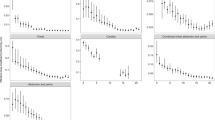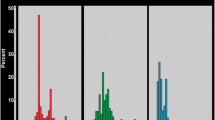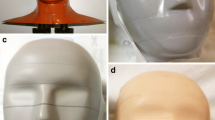Abstract
Background
There is a need for an easily accessible method for effective dose estimation in pediatric CT.
Objective
To estimate effective doses for a variety of pediatric neurological and body CT examinations in five age groups using recently published age- and region-specific dose length product (DLP) to effective dose conversion coefficients.
Materials and methods
A retrospective review was performed of 1,431 consecutive CT scans over a 12-week period using age- and weight-adjusted CT protocols. Age- and region-specific DLP to effective dose conversion coefficients were applied to console-displayed DLP data.
Results
Effective dose estimates for single-phase head CT scans in neonatal, and 1-, 5-, 10- and 15-year-old age groups were 4.2, 3.6, 2.4, 2.0 and 1.4 mSv, respectively. For abdomen/pelvis CT scans the corresponding effective doses were 13.1, 11.1, 8.4, 8.9 and 5.9 mSv. The range of pediatric CT effective doses is wide, from ultralow dose protocols (<1 mSv) to extended-coverage body examinations (10–15 mSv).
Conclusion
Age- and region-specific pediatric DLP to effective dose conversion coefficients provide an accessible and user-friendly method for estimating pediatric CT effective doses that is available to radiologists working without medical physics support.




Similar content being viewed by others
References
Linton OW, Mettler FA (2003) National conference on dose reduction in CT with particular emphasis on pediatric patients. AJR 181:321–329
Blackwell CD, Gorelick M, Holmes JF et al (2007) Pediatric head trauma: changes in use of computed tomography in emergency departments in the United States over time. Ann Emerg Med 49:320–324
Food and Drug Administration (FDA) (2002) Public health notification: reducing radiation risk from computed tomography for pediatric and small adult patients. Pediatr Radiol 32:314–316
Brody AS, Frush DP, Huda W et al; American Academy of Pediatrics Section on Radiology (2007) Radiation risk to children from computed tomography. Pediatrics 120:677–682
McCullough CH, Schueler BA (2000) Educational treatise: calculation of effective dose. Med Phys 27:828–837
Huda W, Vance A (2007) Patient radiation doses from adult and pediatric CT. AJR 188:540–546
ICRP (1991) 1990 recommendations of the International Commission on Radiological Protection (publication no. 60). Pergamon, Oxford, UK
Almen A, Mattsson S (1996) On the calculation of effective dose to children and adolescents. J Radiol Prot 16:81–89
Theocharopoulos N, Damilakis J, Perisinakis K et al (2006) Estimation of effective doses to adult and pediatric patients from multislice computed tomography: a method based on energy imparted. Med Phys 33:3846–3856
CT Safety & Efficacy: A Broad Perspective.2004 CT quality criteria. Appendix A - MSCT dosimetry, guidelines on radiation dose to the patient. Available at http://www.msct.eu/CT_Quality_Criteria.htm. Accessed 16 Jan 2008
European Commission (1999) European guidelines on quality criteria for computed tomography. Report EUR 16262. Office for Official Publications of the European Communities, Brussels. Available at http://www.drs.dk/guidelines/ct/quality/. Accessed 16 Jan 2008
Khursheed A, Hillier MC, Shrimpton PC et al (1997) Influence of patient age on normalized effective doses calculated for CT examinations. Br J Radiol 75:819–830
Huda W, Atherton JV, Ware DE et al (1997) An approach for the estimation of effective radiation dose at CT in pediatric patients. Radiology 203:417–422
Huda W, Gkanatsios NA (1997) Effective dose and energy imparted in diagnostic radiology. Med Phys 24:1311–1316
Shrimpton PC (2004) Assessment of patient dose in CT. NRPB-PE/1/2004. NRPB, Chilton. Also published as Appendix C of the 2004 CT Quality Criteria (MSCT, 2004) at http://www.msct.eu/CT_Quality_Criteria.htm
Shrimpton PC, Hillier MC, Lewis MA et al (2005) Doses from computed tomography examinations in the UK - 2003 review. NRPB - W67, NRPB Publications. Available at http://www.hpa.org.uk/radiation/publications/index.htm
Shrimpton PC, Hillier MC, Lewis MA et al (2006) National survey of doses from CT in the UK: 2003. Br J Radiol 79:968–980
Nickoloff E (2002) Current adult and pediatric CT doses. Pediatr Radiol 32:250–260
Huda W (2002) Effective doses to adult and pediatric patients. Pediatr Radiol 32:272–279
Shrimpton PC, Wall BF (2000) Reference doses for paediatric computed tomography. Radiat Prot Dosimetry 90:249–252
Chapple C-L, Willis S, Frame J (2002) Effective dose in paediatric computed tomography. Phys Med Biol 47:107–115
Committee to Assess Health Risks from Exposure to Low Levels of Ionizing Radiation, National Research Council (2006) Health risks from exposure to low levels of ionizing radiation. BEIR VII Phase 2. National Academies Press, Washington DC
US Food and Drug Administration (2007) What are the radiation risks from CT? Available at http://www.fda.gov/cdrh/ct/risks.html. Accessed 16 Jan 2008
Picano E (2004) Sustainability of medical imaging. BMJ 328:578–580
Mayo JR, Aldrich J, Muller N (2003) Radiation exposure at chest CT: a statement of the Fleishner Society. Radiology 228:15–21
Wintersperger B, Jakobs T, Herzog P et al (2005) Aorto-iliac multidetector-row CT angiography with low kV settings: improved vessel enhancement and simultaneous reduction of radiation dose. Eur Radiol 15:334–341
Hausleiter J, Meyer T, Hadamitzky M et al (2006) Radiation dose estimates from cardiac multislice computed tomography in daily practice: impact of different scanning protocols on effective dose estimates. Circulation 113:1305–1310
Zankl M, Panzer, Drexler G (1993) Tomographic anthropomorphic models. Part II: Organ doses from computed tomographic examinations in paediatric radiology. GSF-Bericht 30/93. GSF, Munich
Hollingsworth C, Frush DP, Cross M et al (2003) Helical CT of the body: a survey of techniques used for pediatric patients. AJR 180:401–406
McLean D, Malitz N, Lewis S (2003) Survey of effective dose levels from typical paediatric protocols. Australas Radiol 47:135–142
Hurwitz LM, Yoshizumi TT, Goodman PC et al (2007) Effective dose determination using an anthropomorphic phantom and metal oxide semiconductor field effect transistor technology for clinical adult body multidetector array computed tomography protocols. J Comput Assist Tomogr 31:544–549
Pages J, Buls N, Osteaux M (2003) CT doses in children: a multicentre study. Br J Radiol 76:803–811
Acknowledgement
We thank Guila BenDavid and her team of CT technologists for their diligent recording of DLP data, which made this study possible.
Author information
Authors and Affiliations
Corresponding author
Rights and permissions
About this article
Cite this article
Thomas, K.E., Wang, B. Age-specific effective doses for pediatric MSCT examinations at a large children’s hospital using DLP conversion coefficients: a simple estimation method. Pediatr Radiol 38, 645–656 (2008). https://doi.org/10.1007/s00247-008-0794-0
Received:
Revised:
Accepted:
Published:
Issue Date:
DOI: https://doi.org/10.1007/s00247-008-0794-0




